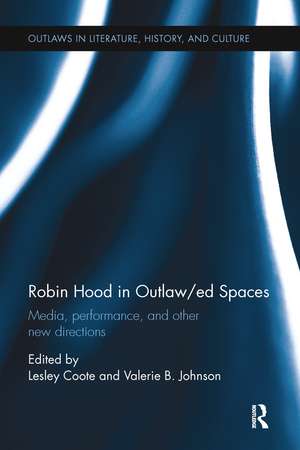Robin Hood in Outlaw/ed Spaces: Media, Performance, and Other New Directions: Outlaws in Literature, History, and Culture
Editat de Lesley Coote, Valerie Johnsonen Limba Engleză Paperback – 30 iun 2021
| Toate formatele și edițiile | Preț | Express |
|---|---|---|
| Paperback (1) | 389.66 lei 6-8 săpt. | |
| Taylor & Francis – 30 iun 2021 | 389.66 lei 6-8 săpt. | |
| Hardback (1) | 820.71 lei 6-8 săpt. | |
| Taylor & Francis – 7 noi 2016 | 820.71 lei 6-8 săpt. |
Preț: 389.66 lei
Nou
Puncte Express: 584
Preț estimativ în valută:
74.56€ • 78.01$ • 61.94£
74.56€ • 78.01$ • 61.94£
Carte tipărită la comandă
Livrare economică 02-16 aprilie
Preluare comenzi: 021 569.72.76
Specificații
ISBN-13: 9781032097459
ISBN-10: 1032097450
Pagini: 250
Dimensiuni: 156 x 234 x 13 mm
Greutate: 0.45 kg
Ediția:1
Editura: Taylor & Francis
Colecția Routledge
Seria Outlaws in Literature, History, and Culture
Locul publicării:Oxford, United Kingdom
ISBN-10: 1032097450
Pagini: 250
Dimensiuni: 156 x 234 x 13 mm
Greutate: 0.45 kg
Ediția:1
Editura: Taylor & Francis
Colecția Routledge
Seria Outlaws in Literature, History, and Culture
Locul publicării:Oxford, United Kingdom
Cuprins
Prologue:
Introduction
Lesley Coote and Valerie B. Johnson
Act I:
Chapter 1: A Forest of Her Own: Greenwood-Space and the Forgotten Female Characters of the Robin Hood Tradition
Valerie B. Johnson
Chapter 2: Mortal Friends in Robin and Gandelyn and the Medieval Robin Hood Ballads
Chris Chism
Chapter 3: The Play’s the Thing: Establishing Boundaries in Anthony Munday’s The Downfall of Robert, Earle of Huntington
Carrie Griffin
Chapter 4: "Strange Genealogies: Robin Hood’s Courtship with Jack Cade’s Daughter and the Creation of a Fraudulent Text"
Alexander Kaufman
Chapter 5: Highwaymen, Robbers, and Rogues in the Twentieth Century: A New Outlaw Fantasy
Kristin Noone
Act II:
Chapter 6: Property not Prophecy: Welsh ‘Outlaws’ Owain Lawgoch and Owain Glyn Dŵr as High Status Landowners
Spencer Gavin Smith
Chapter 7: Revisiting and Revising Robin Hood in Sixteenth-Century London
John Marshall
Chapter 8: Sailing The Little John: John Ward and Legitimizing Outlaw Space
Kristi J. Castleberry
Chapter 9: Relishing the Kill, Becoming a Man: Robin Hood’s Rivalry with Guy of Gisborne
Dana Symons
Chapter 10: Douglas Fairbanks in Robin Hood and its Music
Gillian Anderson
Chapter 11: "And Now Begins Our Game:" Revitalizing the Ludic Robin Hood
Thomas Rowland
Epilogue:
Chapter 12: Parody And Archery: Re-Generating The Robin Hood Tradition
Stephen Knight
Introduction
Lesley Coote and Valerie B. Johnson
Act I:
Chapter 1: A Forest of Her Own: Greenwood-Space and the Forgotten Female Characters of the Robin Hood Tradition
Valerie B. Johnson
Chapter 2: Mortal Friends in Robin and Gandelyn and the Medieval Robin Hood Ballads
Chris Chism
Chapter 3: The Play’s the Thing: Establishing Boundaries in Anthony Munday’s The Downfall of Robert, Earle of Huntington
Carrie Griffin
Chapter 4: "Strange Genealogies: Robin Hood’s Courtship with Jack Cade’s Daughter and the Creation of a Fraudulent Text"
Alexander Kaufman
Chapter 5: Highwaymen, Robbers, and Rogues in the Twentieth Century: A New Outlaw Fantasy
Kristin Noone
Act II:
Chapter 6: Property not Prophecy: Welsh ‘Outlaws’ Owain Lawgoch and Owain Glyn Dŵr as High Status Landowners
Spencer Gavin Smith
Chapter 7: Revisiting and Revising Robin Hood in Sixteenth-Century London
John Marshall
Chapter 8: Sailing The Little John: John Ward and Legitimizing Outlaw Space
Kristi J. Castleberry
Chapter 9: Relishing the Kill, Becoming a Man: Robin Hood’s Rivalry with Guy of Gisborne
Dana Symons
Chapter 10: Douglas Fairbanks in Robin Hood and its Music
Gillian Anderson
Chapter 11: "And Now Begins Our Game:" Revitalizing the Ludic Robin Hood
Thomas Rowland
Epilogue:
Chapter 12: Parody And Archery: Re-Generating The Robin Hood Tradition
Stephen Knight
Notă biografică
Lesley Coote is a lecturer in the Department of English at the University of Hull, where she teaches Chaucer, medieval romance literature and culture, historical film, ‘Arthuriana’ and Robin Hood studies. Her research specializations are the ‘popular’ culture of medieval Britain, in particular prophetic, apocalyptic and romance texts, in addition to the medievalism of film and new media. She has written a wide variety of articles and essays on these topics, and a book, Prophecy and Public Affairs in Later Medieval England (2000). She is currently preparing an article on medievalism and film in the twenty-first century, and a book, Robin Hood, for Reaktion Press.
Valerie B. Johnson is a lecturer at the University of Maryland, College Park, and a former Marion L. Brittain Postdoctoral Fellow at the Georgia Institute of Technology. She received her Ph.D. from the University of Rochester. Dr. Johnson has worked extensively with Robin Hood in digital contexts, serving as the contributing editor and designer of The Robin Hood Project from 2006-2012, the web master of Robin Hood Scholars (http://robinhoodscholars.blogspot.com/), and is a founding editor of the open access Bulletin of the International Association for Robin Hood Studies. Her publications include articles in Studies in Medievalism, Year’s Work in Medievalism, Once and Future Classroom, as well as contributions to edited collections.
Valerie B. Johnson is a lecturer at the University of Maryland, College Park, and a former Marion L. Brittain Postdoctoral Fellow at the Georgia Institute of Technology. She received her Ph.D. from the University of Rochester. Dr. Johnson has worked extensively with Robin Hood in digital contexts, serving as the contributing editor and designer of The Robin Hood Project from 2006-2012, the web master of Robin Hood Scholars (http://robinhoodscholars.blogspot.com/), and is a founding editor of the open access Bulletin of the International Association for Robin Hood Studies. Her publications include articles in Studies in Medievalism, Year’s Work in Medievalism, Once and Future Classroom, as well as contributions to edited collections.
Descriere
This collection examines the figure of Robin Hood within geographical, cultural and temporal spaces. The volume is divided into two sections: the first features an interrogation of literary spaces to uncover the critical grounds in which the Robin Hood ’legend’ has traditionally operated. The essays in Part Two take up issues related to performativ







